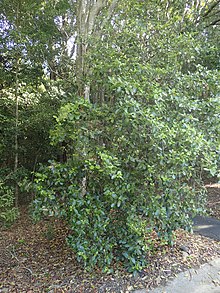Elaeodendron australe
| Red olive-berry | |
|---|---|

| |
| Leaves and female flowers in Coffs Harbour Botanic Garden | |
| Scientific classification | |
| Kingdom: | Plantae |
| Clade: | Tracheophytes |
| Clade: | Angiosperms |
| Clade: | Eudicots |
| Clade: | Rosids |
| Order: | Celastrales |
| Family: | Celastraceae |
| Genus: | Elaeodendron |
| Species: | E. australe
|
| Binomial name | |
| Elaeodendron australe | |
| Synonyms[1] | |


Elaeodendron australe, commonly known as red olive-berry, red-fruited olive plum, or blush boxwood,[2] is a species of flowering plant in the family Celastraceae and is endemic to eastern Australia. It is a shrub or small tree with egg-shaped to oblong leaves with a wavy margin, yellowish green male and female flowers on separate plants and fleshy orange-red fruit.
Description[edit]
Elaeodendron australe is a shrub or small tree that typically grows to a height of 8 m (26 ft) and has separate male and female plants. The leaves are mostly arranged in opposite pairs and are egg-shaped to elliptic or oblong with a wavy edge, 27–150 mm (1.1–5.9 in) long and 4–70 mm (0.16–2.76 in) wide on a petiole 4–10 mm (0.16–0.39 in) long. Elaeodendron australe is dioecious; that is, male and female flowers are borne on separate plants. The flowers are arranged in cymes in leaf axils, on a peduncle up to 12 mm (0.47 in) long, each flower on a pedicel 3–7 mm (0.12–0.28 in) long. The four petals are yellowish-green, about 4 mm (0.16 in) long. Male flowers have four stamens and female flowers have four staminodes. Flowering occurs in spring and summer and the fruit is a fleshy, oblong to oval, orange-red drupe 10–25 mm (0.39–0.98 in) long. The fruit is ripe from March to July and often persists on the tree for many months.[2][3][4][5]
Taxonomy[edit]
Elaeodendron australe was first formally described in 1805 by Étienne Pierre Ventenat in his book Jardin de la Malmaison.[6][7]
In 1825, de Candolle described two varieties in Prodromus Systematis Naturalis Regni Vegetabilis and the names are accepted by the Australian Plant Census:
- Elaeodendron australe Vent. var. australe[8] that has leaves less than four times as long as broad, and mostly more than 15 mm (0.59 in) wide;[3]
- Elaeodendron australe var. integrifolium (Tratt.) DC. (previously known as Portenschlagia integrifolia)[9][10] that has leaves more than four times as long as broad, and less than 15 mm (0.59 in) wide.[3]
Distribution and habitat[edit]
Red olive-berry grows in eucalypt and rainforest ecotone areas, and in littoral or dry rainforest. It is found in north-eastern and central eastern Queensland and as far south as Tuross Head in New South Wales. An unusual thick-leaved form occurs in Mount Kaputar National Park and nearby western slopes and dry tableland gorges.[2][3][5]
Use in horticulture[edit]
Seed germination is very slow, but reliable with around a 25% success rate after twelve months.[5]
References[edit]
- ^ a b "Elaeodendron australe". Australian Plant Census. Retrieved 13 September 2020.
- ^ a b c F.A.Zich; B.P.M.Hyland; T.Whiffen; R.A.Kerrigan (2020). "Elaeodendron australe var. australe". Australian Tropical Rainforest Plants Edition 8 (RFK8). Centre for Australian National Biodiversity Research (CANBR), Australian Government. Retrieved 25 June 2021.
- ^ a b c d Conn, Barry J. "Elaeodendron australe". Royal Botanic Garden Sydney. Retrieved 13 September 2020.
- ^ Jessup, Laurence W. "Cassine australis (Vent.) Kuntze". Australian Biological Resources Study, Department of Agriculture, Water and the Environment: Canberra. Retrieved 14 September 2020.
- ^ a b c Floyd, Alexander G. (1989). Rainforest Trees of Mainland South-eastern Australia. Victoria: Inkata Press. p. 88. ISBN 0909605572.
- ^ "Elaeodendron australe". APNI. Retrieved 14 September 2020.
- ^ Ventenat, Étienne Pierre (1805). Jardin de la Malmaison. Paris: De l'imprimerie de Crapelet, et se trouve chez l'auteur. p. 117. Retrieved 14 September 2020.
- ^ "Elaeodendron australe var. australe". Australian Plant Census. Retrieved 14 September 2020.
- ^ "Portenschlagia integrifolia". APNI. Retrieved 14 September 2020.
- ^ "Elaeodendron australe var. integrifolium". Australian Plant Census. Retrieved 14 September 2020.
